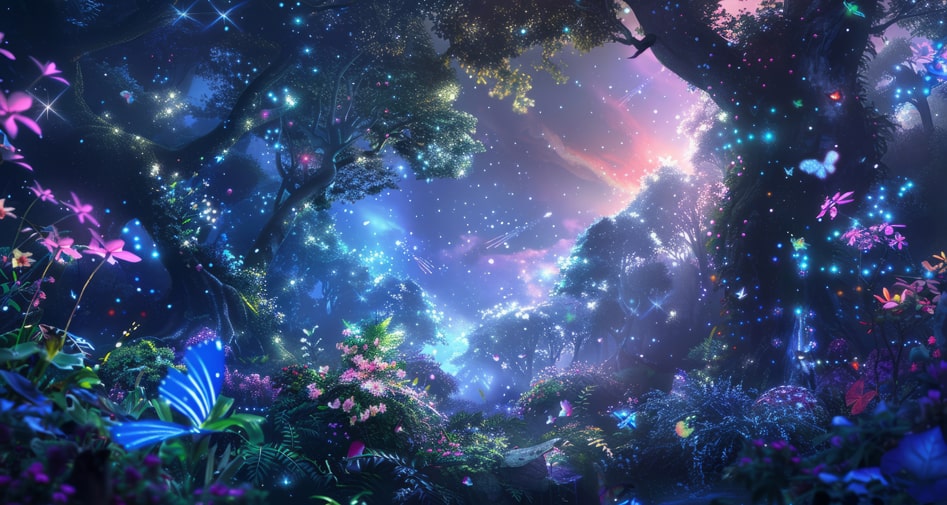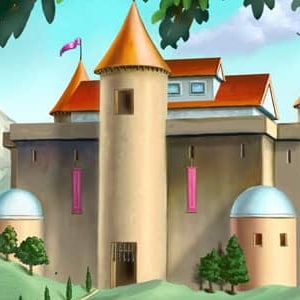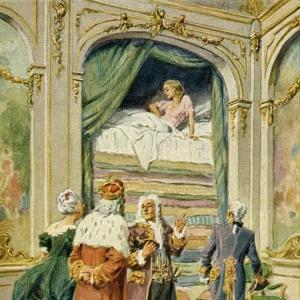Reading time: 8 min
There was once a butterfly who wished for a bride, and, as may be supposed, he wanted to choose a very pretty one from among the flowers. He glanced, with a very critical eye, at all the flower-beds, and found that the flowers were seated quietly and demurely on their stalks, just as maidens should sit before they are engaged; but there was a great number of them, and it appeared as if his search would become very wearisome. The butterfly did not like to take too much trouble, so he flew off on a visit to the daisies. The French call this flower „Marguerite,“ and they say that the little daisy can prophesy. Lovers pluck off the leaves, and as they pluck each leaf, they ask a question about their lovers; thus: „Does he or she love me?– Ardently? Distractedly? Very much? A little? Not at all?“ and so on. Every one speaks these words in his own language. The butterfly came also to Marguerite to inquire, but he did not pluck off her leaves. He pressed a kiss on each of them, for he thought there was always more to be done by kindness.
„Darling Marguerite daisy,“ he said to her, „you are the wisest woman of all the flowers. Pray tell me which of the flowers I shall choose for my wife. Which will be my bride? When I know, I will fly directly to her, and propose.“
But Marguerite did not answer him. She was offended that he should call her a woman when she was only a girl; and there is a great difference. He asked her a second time, and then a third; but she remained dumb, and answered not a word. Then he would wait no longer, but flew away, to commence his wooing at once. It was in the early spring, when the crocus and the snowdrop were in full bloom.
„They are very pretty,“ thought the butterfly; „charming little lasses; but they are rather formal.“
Then, as the young lads often do, he looked out for the elder girls. He next flew to the anemones; these were rather sour to his taste. The violet, a little too sentimental. The lime-blossoms, too small, and besides, there was such a large family of them. The apple-blossoms, though they looked like roses, bloomed today, but might fall off to-morrow, with the first wind that blew; and he thought that a marriage with one of them might last too short a time. The pea-blossom pleased him most of all. She was white and red, graceful and slender, and belonged to those domestic maidens who have a pretty appearance, and can yet be useful in the kitchen. He was just about to make her an offer, when, close by the maiden, he saw a pod, with a withered flower hanging at the end.
„Who is that?“ he asked.
„That is my sister,“ replied the pea-blossom.
„Oh, indeed; and you will be like her some day,“ said he; and he flew away directly, for he felt quite shocked.
A honeysuckle hung forth from the hedge, in full bloom; but there were so many girls like her, with long faces and sallow complexions. No. He did not like her. But which one did he like?
Spring went by, and summer drew towards its close; autumn came; but he had not decided. The flowers now appeared in their most gorgeous robes, but all in vain. They had not the fresh, fragrant air of youth. For the heart asks for fragrance, even when it is no longer young; and there is very little of that to be found in the dahlias or the dry chrysanthemums; therefore the butterfly turned to the mint on the ground. You know, this plant has no blossom; but it is sweetness all over,– full of fragrance from head to foot, with the scent of a flower in every leaf.
„I will take her,“ said the butterfly; and he made her an offer. But the mint stood silent and stiff, as she listened to him. At last she said,–
„Friendship, if you please; nothing more. I am old, and you are old, but we may live for each other just the same; as to marrying– no; don’t let us appear ridiculous at our age.“
And so it happened that the butterfly got no wife at all. He had been too long choosing, which is always a bad plan. And the butterfly became what is called an old bachelor.
It was late in the autumn, with rainy and cloudy weather. The cold wind blew over the bowed backs of the willows, so that they creaked again. It was not the weather for flying about in summer clothes; but fortunately the butterfly was not out in it. He had got a shelter by chance. It was in a room heated by a stove, and as warm as summer. He could exist here, he said, well enough.
„But it is not enough merely to exist,“ said he, „I need freedom, sunshine, and a little flower for a companion.“
Then he flew against the window-pane, and was seen and admired by those in the room, who caught him, and stuck him on a pin, in a box of curiosities. They could not do more for him.
„Now I am perched on a stalk, like the flowers,“ said the butterfly. „It is not very pleasant, certainly. I should imagine it is something like being married. For here I am stuck fast.“ And with this thought he consoled himself a little.
„That seems very poor consolation,“ said one of the plants in the room, that grew in a pot.
„Ah,“ thought the butterfly, „one can’t very well trust these plants in pots. They have too much to do with mankind.“
 Learn languages. Double-tap on a word.Learn languages in context with Childstories.org and Deepl.com.
Learn languages. Double-tap on a word.Learn languages in context with Childstories.org and Deepl.com.Backgrounds
Interpretations
Adaptions
Summary
Linguistics
„The Butterfly“ is a fairy tale written by Danish author Hans Christian Andersen, who is well-known for his extensive collection of enchanting and thought-provoking stories. Born on April 2, 1805, Andersen wrote various literary works, including plays, novels, poems, and travelogues, but is most famous for his fairy tales. His stories have been translated into over 125 languages and have become a significant part of children’s literature worldwide.
Some of Andersen’s most famous works include „The Little Mermaid,“ „The Ugly Duckling,“ „The Emperor’s New Clothes,“ „Thumbelina,“ and „The Snow Queen.“ His fairy tales often provide moral lessons and insights into human nature, combining elements of fantasy, folklore, and reality. His stories continue to captivate readers of all ages and inspire adaptations in different forms of media, such as film, television, and theater.
„The Butterfly“ is one of Andersen’s lesser-known tales but follows his signature style of exploring themes related to love, choice, and human relationships. While the tale is not as widely recognized as some of his other works, it still offers valuable lessons and serves as a reflection of Andersen’s unique storytelling approach.
„The Butterfly“ offers several interpretations, reflecting on various themes such as indecision, superficiality, the passage of time, and the search for companionship.
Indecision: The butterfly’s inability to choose a bride leads him to miss out on finding a suitable partner. This highlights the importance of making decisions and taking action rather than continually postponing decisions out of fear or hesitation.
Superficiality: The butterfly judges each flower based on their appearance and his own expectations, dismissing them for minor faults. This story serves as a cautionary tale against superficiality and encourages readers to look beyond appearances when considering relationships or friendships.
The passage of time: As the butterfly spends the entire spring and summer searching for a bride, he fails to realize that time is passing by, and his options are dwindling. This emphasizes the inevitability of change and the importance of making the most of our time, opportunities, and relationships.
The search for companionship: The butterfly’s journey highlights the universal desire for companionship, love, and connection. In the end, the butterfly settles for a friendship with the mint plant, illustrating the importance of companionship and how it can take various forms.
Human influence: The story also comments on the relationship between humans and nature, represented by the potted plant in the room. It suggests that human influence can lead to a distortion of perspectives, as seen in the butterfly’s skepticism towards the potted plant’s opinion.
In conclusion, „The Butterfly“ offers a rich exploration of themes relevant to human relationships, decision-making, and the passage of time. The story serves as a reminder to be mindful of these aspects in our own lives and to value the connections we have with others.
„The Butterfly“ by Hans Christian Andersen has been adapted into various forms of media, including:
Film adaptations: There have been several film adaptations of „The Butterfly,“ including the 1972 Soviet film „The Butterfly,“ directed by Andrei Tarkovsky, and the 1983 animated short film „The Butterfly,“ directed by Yuri Norstein.
Stage adaptations: The story has been adapted for the stage in various forms, including plays and ballets. For example, the Royal Danish Ballet has a ballet adaptation of „The Butterfly“ that was first performed in 2018.
Picture books: There are many picture book adaptations of „The Butterfly“ available for young readers, including adaptations by Eric Carle, Jerry Pinkney, and Will Moses.
Musical adaptations: „The Butterfly“ has also been adapted into musical form, such as the 2009 musical „The Butterfly Lovers,“ which is based on a Chinese legend that shares similarities with Andersen’s story.
Art installations: Artists have created installations inspired by „The Butterfly,“ including the 2018 installation „The Butterfly Room“ by artist Lucy Sparrow, which featured a room filled with handmade felt butterflies.
Overall, „The Butterfly“ has inspired numerous adaptations across a wide range of media, demonstrating the enduring popularity and relevance of Andersen’s classic fairy tale.
„The Butterfly“ is a fairy tale by Hans Christian Andersen that tells the story of a butterfly searching for a bride among the flowers. The butterfly starts by seeking advice from the wise Marguerite daisy, but she refuses to answer him, offended that he called her a woman instead of a girl. Undeterred, the butterfly embarks on his quest to find a bride, evaluating each flower he encounters.
As spring turns to summer, he scrutinizes crocuses, snowdrops, anemones, violets, lime-blossoms, and apple-blossoms, but finds fault with each one. The pea-blossom catches his eye, but the sight of her withered sister dissuades him from pursuing her. As autumn approaches, the butterfly’s options dwindle, and he turns to the mint plant. However, she only agrees to be his friend, rejecting the idea of marriage due to their old age.
Eventually, the butterfly becomes an old bachelor and seeks refuge from the cold in a warm room. He longs for freedom, sunshine, and a flower companion but is captured and pinned in a box of curiosities. Comparing his predicament to being married, he finds solace in his situation, though a potted plant in the room scoffs at his consolation. The butterfly dismisses the plant’s opinion, believing it to be too influenced by humans.
In summary, „The Butterfly“ is a tale that teaches the consequences of indecision and the importance of not being overly critical when searching for a partner.
Hans Christian Andersen’s fairy tale „The Butterfly“ provides a rich narrative for linguistic analysis, showcasing several themes and stylistic features characteristic of Andersen’s storytelling. Here is an analysis focusing on language use, themes, and narrative structure:
Themes
The Quest for Love and Choice: The butterfly’s search for a bride is a metaphor for the complexities and challenges of choosing a life partner. The theme is reminiscent of courtship rituals and the societal expectations surrounding marriage.
Indecision and its Consequences: The butterfly’s inability to make a decision highlights the paralysis that can accompany an abundance of choices, leading ultimately to loneliness.
Nature and Personification: Andersen gives human traits to flowers and the butterfly, implying deeper connections between human emotions and the natural world.
Aging and the Passage of Time: The progression from spring to autumn symbolizes the cycle of life and the consequences of delaying important decisions.
Narrative Structure
Introduction: The story begins by establishing the butterfly’s quest for a bride, setting the stage for his interactions with various flowers.
The Butterfly’s Journey: The narrative follows the butterfly as he encounters different flowers, each characterized with distinct human-like qualities, representing various potential partners.
Climax: The butterfly finally encounters the mint, who offers friendship but not marriage, marking the culmination of his futile search.
Resolution: The butterfly’s capture and placement on a pin signify the end of his freedom and quest, offering a bittersweet conclusion.
Personification: Flowers are depicted with human-like traits („the flowers were seated quietly and demurely“), adding a whimsical yet poignant quality to the narrative.
Dialogue and Direct Address: The engaging dialogue between the butterfly and the flowers, especially the mint, brings the characters to life and conveys deeper meanings succinctly.
Symbolism: Flowers symbolize different life stages, temperaments, and societal roles (e. g. , violets are “sentimental,” apple-blossoms symbolize ephemeral beauty).
Irony: The butterfly’s final fate, pinned like a specimen in a box, is ironic compared to the freedom he sought throughout the tale.
Repetition: The repetition of inquiries to Marguerite, and later to other flowers, emphasizes the butterfly’s persistent but ultimately fruitless quest.
Moral and Reflection: The story ends with a reflective comment from the butterfly, suggesting a parallel between the stasis of his current situation and the institution of marriage. This moral contemplation evokes traditional fairy tale endings that impart wisdom.
In conclusion, Andersen skillfully intertwines linguistic elements with thematic depth, crafting a narrative that is both entertaining and thought-provoking. Through „The Butterfly,“ Andersen examines themes of love, choice, and the passage of time, using the language and structure of a fairy tale to reflect on human nature.
Information for scientific analysis
Fairy tale statistics | Value |
|---|---|
| Translations | DE, EN, DA, ES, FR, IT |
| Readability Index by Björnsson | 26.4 |
| Flesch-Reading-Ease Index | 84.1 |
| Flesch–Kincaid Grade-Level | 5 |
| Gunning Fog Index | 7.5 |
| Coleman–Liau Index | 7.9 |
| SMOG Index | 8.1 |
| Automated Readability Index | 4.5 |
| Character Count | 5.188 |
| Letter Count | 3.924 |
| Sentence Count | 70 |
| Word Count | 975 |
| Average Words per Sentence | 13,93 |
| Words with more than 6 letters | 122 |
| Percentage of long words | 12.5% |
| Number of Syllables | 1.251 |
| Average Syllables per Word | 1,28 |
| Words with three Syllables | 51 |
| Percentage Words with three Syllables | 5.2% |

 Facebook
Facebook  Whatsapp
Whatsapp  Messenger
Messenger  Telegram
Telegram Reddit
Reddit















